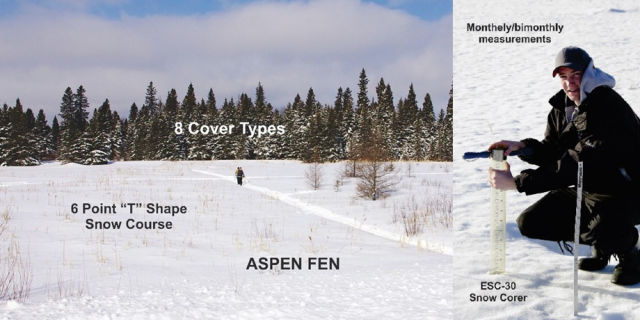
By
Roderick A. McGinn and Dion J. Wiseman
December 2023
Print Version
What you need to know
Snowmelt water, whether held within the snowpack or delivered to soils, wetlands, and streams, sustains prairie and boreal lakes and wetlands. It is a medium for nutrient transfer and critical for life in the variety of ecosystems within Riding Mountain National Park (RMNP).
Monthly accumulations of snow are ecologically significant with respect to soil insulation, nival biology, ungulate and predator mobility, and the ensuing snowmelt freshet impacts lake, pond and wetland recharge, aquatic ecosystems, and flood regimes.
Why this research is important
Long-term ecological planning relies on meteorological and climate data collected over a thirty-year period, referred to as the climate normal. Consequently, determining an estimate of average snow accumulation, snowpack properties, and snowmelt runoff requires an extended period of continual data collection. Furthermore, advanced research into decadal variations, drought cycles, lake level oscillations, water balances, the impacts of el Niño/la Nina (ENSO) events, and other cyclic oscillations are likewise contingent on reliable, long-term data.
In RMNP, 23.6% of the annual precipitation falling on the Clear Lake Watershed accrues in the five-month winter snowpack accumulation period. That is approximately 115 mm of snow-water-equivalent depth (SWE) accumulates from November to March, which is stored as snowpack in forests, meadows, fields, and on frozen lakes and wetlands. Normally, this water is released within a two-to-three-week period in April.
How this research is conducted
In late winter 1995, 13 snowpack survey courses were established over the natural vegetative surfaces common to the Clear Lake Watershed. At each sampling point along a snow course, the snowpack depth, SWE depth, and snowpack mean density have been measured using prescribed meteorological instrumentation and procedures. Standard meteorological and snowpack data collection began in the spring of 1995 and has continued until today.
What the researchers found
In the Clear Lake Watershed, the 30-year normal annual snow accumulation displays properties of a prairie/tundra snowpack, a relatively shallow depth dominated by wind slab over dry fine grain snow and depth hoar. The normal snowpack ranges from 4.1 cm SWE in droughty winters to 13.8 cm SWE in the heavier snowfall winters. The mean 30-year normal potential snowmelt runoff, theoretically draining into Clear Lake, is estimated to be 12,170 dam3, a volume that would raise the lake level by 85 cm. However, watershed sublimation/evapotranspiration losses, soil infiltration, and depression/detention storage significantly attenuate potential runoff.
Over this period of time, efforts to improve snowmelt forecasting have led to ancillary research projects in snowmelt modelling, sublimation/evapotranspiration loss, soil infiltration loss, and depression/detention storage within the watershed. Other related research has focused on the dry deposition of nitrogen and phosphorus nutrients in snowfall, macronutrient concentrations in snowmelt, and lake-outlet runout.
The 30-year mean normal snowmelt runoff draining into Clear Lake is estimated to be 4,510 dam3 ±3,452 dam3, a variable volume depending on winter climatology that will normally raise the lake level by 31 cm each spring but can double the water level rise following a low frequency (1 in 25 years) snowmelt freshet.
How this research can be used
Monthly snowpack data is of value to park wardens in the day-to-day operations at RMNP. Runoff and flood forecasting is of particular value with respect to trail and road maintenance and townsite service operations. Estimates of open-water lake levels are useful in the operation of town site water and wastewater systems and planning for lakeside swimming, boating, and a variety of other recreational activities.
From an academic perspective, this continuous data set is of particular value in snow, lake and wetland ecology and the overall watershed energy, nutrient and water balances.
Acknowledgements
RMNP equipment and logistics grant “The Clear Lake Basin Project 1994–1999,” additional logistic support provided by dedicated wardens and staff at RMNP and numerous undergraduate students (<40) in the Department of Geography and Environment.
About the Researchers
Keywords
- lake levels
- Riding Mountain National Park
- snowmelt
- snowpack
Publications Based on the Research
Over the course of 30 years, seven undergraduate theses, 38 technical reports, and 17 senior undergraduate practica have been written. Twenty professional papers related to these theses, reports, and practica have been published in peer-reviewed or edited journals. Annual reports are stored in the RMNP library in Wasagaming, Manitoba; theses and senior practica are housed with the Department of Geography and Environment at Brandon University.
Editor: Christiane Ramsey
Read more BU Research
Research at Brandon University follows comprehensive policies designed to safeguard ethics, to ensure academic integrity, to protect human and animal welfare and to prevent conflicts of interest.


